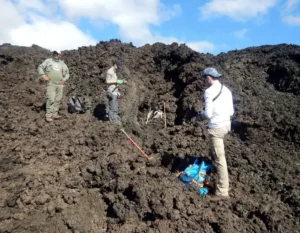A different kind of magma may lurk below.
This article is well suited to Earth and Space, Chemistry and Physics students in years 6, 8, 9, and 10 who are learning about the importance of a scientific understanding of volcanoes to protect society.
Word Count: 439

Volcanoes are potentially dangerous, but this can be tempered by their consistency. Many produce similar eruptions over millions of years, making hazard planning a little easier.
It seems we can’t necessarily take that for granted, however.
Volcanologists working on remote islands in the Galápagos Archipelago have found that two volcanoes known to reliably produce small basaltic lava eruptions (Wolf Volcano erupted in 2015) hide chemically diverse magmas underground, including some with the potential to generate explosive activity.
Lava eruptions and subsequent lava flows look dramatic, whether in the Galápagos, Iceland or Hawaii, but as they generally move at a walking pace they don’t pose quite the same risk as the larger explosive eruptions that hit Vesuvius or Mount St Helens.
Michael Stock from Trinity College Dublin stresses “there’s no sign” the two volcanoes the researchers studied will undergo a transition in eruption style any time soon, but says the findings show why other volcanoes might have changed their behaviour in the past.

“The study will also help us to better understand the risks posed by volcanoes in other parts of the world. Just because they’ve always erupted a particular way in the past doesn’t mean you can rely on them to continue doing the same thing indefinitely into the future.”
Stock is the lead author of a paper in the journal Nature Communications. He worked with colleagues from the UK, the US and Ecuador.
By deciphering the compositions of microscopic crystals in the lavas, the researchers were able to reconstruct the chemical and physical characteristics of magmas stored beneath the volcanoes.
They believe volcanoes consistently erupt compositionally uniform basaltic lavas when the amount of magma flushing through the ground beneath the edifice is high enough to “overprint” any chemical diversity. This can occur when volcanoes are located close to a hot spot – a plume of hot magma rising towards the surface from deep within the Earth.
However, the chemically diverse magmas they discovered could become mobile and ascend towards the surface under certain circumstances, they say. In this case, volcanoes that have reliably produced basaltic lava eruptions for millennia might undergo unexpected changes to more explosive activity in the future.
“This was really unexpected,” says Stock. “We started the study wanting to know why these volcanoes were so boring and what process caused the erupted lava compositions to remain constant over long timescales.
“Instead we found that they aren’t boring at all: they just hide these secret magmas under the ground.”
Benjamin Bernard from Ecuador’s Instituto Geofísico, who is involved in monitoring Galápagos volcanoes, says the “discovery is a game-changer because it allows us to reconcile apparently divergent observations…”
This article is originally published by Cosmos as Volcanoes aren’t always what they seem.
Login or Sign up for FREE to download a copy of the full teacher resource





